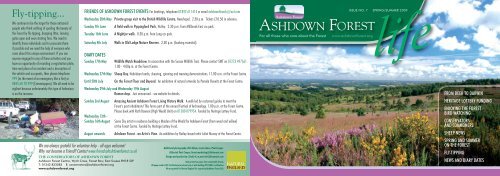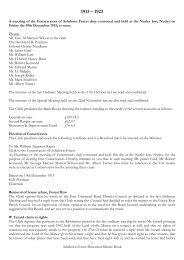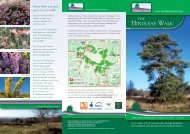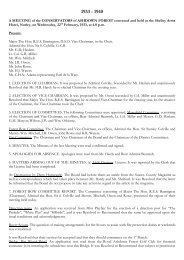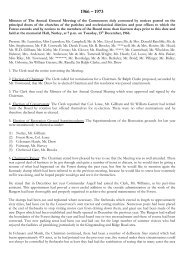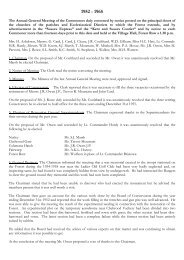Ash Life spring 09:Layout 1 - Ashdown Forest
Ash Life spring 09:Layout 1 - Ashdown Forest
Ash Life spring 09:Layout 1 - Ashdown Forest
Create successful ePaper yourself
Turn your PDF publications into a flip-book with our unique Google optimized e-Paper software.
Fly-tipping...<br />
We continue to be the target for those antisocial<br />
people who think nothing of spoiling the beauty of<br />
the <strong>Forest</strong> by fly-tipping, dropping litter, leaving<br />
gates open and even starting fires. We need to<br />
identify these individuals and to prosecute them<br />
if possible and we need the help of everyone who<br />
cares about this unique environment. If you see<br />
anyone engaged in any of these activities and you<br />
have an opportunity of recording a registration plate,<br />
time and place of an incident and a description of<br />
the vehicle and occupants, then please telephone<br />
999 (in the event of an emergency like a fire) or<br />
0845 60 70 999 (Crimestoppers). We all need to be<br />
vigilant because unfortunately this type of behaviour<br />
is on the increase.<br />
FRIENDS OF ASHDOWN FOREST EVENTS For bookings, telephone 01892 611414 or email ashdownfriends@aol.com<br />
Wednesday 20th May Private group visit to the British Wildlife Centre, Newchapel. 2.30 p.m. Tickets £10.50 in advance.<br />
Sunday 7th June<br />
Tuesday 16th June<br />
Saturday 4th July<br />
A field walk in Pippingford Park, Nutley. 2.30 p.m. from Millbrook East car park.<br />
A Nightjar walk. 8.30 p.m. from Long car park.<br />
Walk in Old Lodge Nature Reserve. 2.30 p.m. (booking essential).<br />
DIARY DATES<br />
Sunday 17th May Wildlife Watch Roadshow. In association with the Sussex Wildlife Trust. Please contact SWT on 01273 497561.<br />
1.00 - 4.00p.m. at the <strong>Forest</strong> Centre.<br />
Wednesday 27th May<br />
Until 20th July<br />
Sheep Day. Hebridean lambs, shearing, spinning and weaving demonstrations. 11.00 a.m. at the <strong>Forest</strong> Centre.<br />
On the <strong>Forest</strong> Floor and Beyond. An exhibition of natural artworks by Pamela Hurwitz at the <strong>Forest</strong> Centre.<br />
Wednesday 29th July and Wednesday 19th August<br />
Roman days. Just announced - see website for details.<br />
Sunday 2nd August<br />
Wednesday 12th -<br />
Sunday 16th August<br />
August onwards<br />
We are always grateful for volunteer help - all ages welcome!<br />
Why not become a Friend Contact www.friendsofashdownforest.co.uk<br />
THE CONSERVATORS OF ASHDOWN FOREST<br />
<strong>Ash</strong>down <strong>Forest</strong> Centre, Wych Cross, <strong>Forest</strong> Row, East Sussex RH18 5JP<br />
T: 01342 823583 E: conservators@ashdownforest.org<br />
www.ashdownforest.org<br />
Amazing Ancient <strong>Ash</strong>down <strong>Forest</strong> Living History Walk. A walk led by costumed guides to meet the<br />
<strong>Forest</strong>'s past inhabitants! This forms part of the annual Festival of Archaeology. 1.00 p.m. at the <strong>Forest</strong> Centre.<br />
Please book with Ruth Dawson (High Weald Unit) on 01580 879954. Funded by Heritage Lottery Fund.<br />
Same Sky artist in residence building a Maiden of the Weald for <strong>Ash</strong>down <strong>Forest</strong> (from wood and willow)<br />
at the <strong>Forest</strong> Centre. Funded by Heritage Lottery Fund.<br />
<strong>Ash</strong>down <strong>Forest</strong> - an Artist's View. An exhibition by Nutley-based artist Juliet Murray at the <strong>Forest</strong> Centre.<br />
Additional photography: Rich Allum, Louise Amos, Paul Cooper.<br />
Editorial: Paul Cooper, forest.marketing@btinternet.com<br />
Design and production: Studio 4, m.marriott@btconnect.com<br />
Only printed on paper from sustainable forests.<br />
All paper used is FSC Certified and produced only at mills holding ISO 14001 certification.<br />
We are grateful to Natural England for supporting <strong>Ash</strong>down <strong>Forest</strong> <strong>Life</strong>.<br />
ISSUE NO. 7 SPRING/SUMMER 20<strong>09</strong><br />
ASHDOWN FOREST<br />
For all those who care about the <strong>Forest</strong> www.ashdownforest.orglife<br />
FROM DEER TO DARWIN<br />
HERITAGE LOTTERY FUNDING<br />
ENJOYING THE FOREST -<br />
BIRD WATCHING<br />
CONSERVATORS<br />
AND COMMONERS<br />
SHEEP NEWS<br />
SPRING AND SUMMER<br />
ON THE FOREST<br />
FLY-TIPPING<br />
NEWS AND DIARY DATES
Welcome<br />
Cover: Wrens Warren -<br />
photograph by Dave Brooker<br />
Enjoying the heath<br />
One of many! -<br />
photograph by Matt Pitts<br />
Welcome to the summer 20<strong>09</strong> issue of <strong>Ash</strong>down <strong>Forest</strong> <strong>Life</strong>. As you<br />
can see we have increased the size from 8 to 12 pages due to the<br />
popularity of the publication and the positive response we have had.<br />
In this issue we cover a wide range of topics from deer to Darwin,<br />
explain the make-up of the Board of Conservators and the role of<br />
commoners, bring you up to date with all the news and highlight<br />
some of those aspects that still cause real concern such as deer<br />
collisions and fly-tipping.<br />
We have also taken advantage of our extra pages to explain the<br />
various ways you can gain the most enjoyment from visiting the<br />
<strong>Forest</strong>. Whether you come to walk the dog, have a picnic, ride a<br />
horse, watch for birds or simply stroll over the open heath and<br />
enjoy the wildlife and spectacular views, we will give you tips<br />
on the best places to go, at what time and what you may see.<br />
In this issue we are featuring bird watching and hopefully this<br />
will help and encourage people to start this fascinating pastime<br />
in an environment where rare species can be seen. Our ongoing<br />
programme of heath restoration is really having a positive<br />
effect on wildlife.<br />
Thanks again to Natural England for their funding of various<br />
aspects of our work including this publication.<br />
Let’s hope for a drier summer than the last!<br />
Hew Prendergast CLERK TO THE CONSERVATORS<br />
From deer...<br />
Like the New <strong>Forest</strong>, <strong>Ash</strong>down <strong>Forest</strong> was created for the hunting of deer.<br />
It was enclosed as a royal hunting ground by the 13th century,<br />
its boundary created by a “pale” of bank and ditch that<br />
is still visible today in some places.<br />
Over the centuries the original population of<br />
red deer disappeared from the <strong>Forest</strong> and the<br />
population of fallow deer has fluctuated<br />
between none at the end of the 17th century,<br />
when the pale was no longer maintained,<br />
to the very high numbers we see today.<br />
In the 1970s there were about 250 fallow on<br />
the <strong>Forest</strong>. Now twice as many get killed on<br />
local roads every year. To deal with casualties<br />
over an ever larger area, the <strong>Ash</strong>down Area<br />
Deer Group, with representatives from<br />
East Sussex County Council, Sussex Police,<br />
the Deer Initiative, the RSPCA, the British<br />
Deer Society, land-owners and the<br />
Conservators, has this year been training<br />
up deer wardens. The Group’s efforts also<br />
produced the conspicuous deer warning<br />
signs on the A22 between Wych Cross and<br />
Nutley – a stretch of road with the highest<br />
recorded number of deer casualties anywhere<br />
in the whole country.<br />
Away from the roads, the Deer Group has<br />
been collating information about the extent of<br />
damage done by deer in the local environment<br />
(for example to trees and woodlands).<br />
While everyone seems to like deer, there is<br />
increasing realisation throughout the country<br />
that their increasing numbers may need some<br />
form of management.<br />
The Deer Group minutes may be seen at<br />
www.ashdownforest.org/conservation/deer.php<br />
3
...to Darwin<br />
Few can be unaware that 20<strong>09</strong> is the 200th anniversary<br />
of the birth of Charles Darwin and the 150th year since<br />
the publication of ‘On the Origin of Species’. What may<br />
be less well known is that <strong>Ash</strong>down <strong>Forest</strong> also had a role<br />
to play in his extraordinarily productive scientific life.<br />
"During the summer of 1860, I was surprised by<br />
finding how large a number of insects were<br />
caught by the leaves of the common sundew<br />
(Drosera Drosera rotundifolia) on a heath in Sussex.<br />
I had heard that insects were thus caught, but<br />
knew nothing further on the subject."<br />
These are the opening words of his book ‘Insectivorous<br />
Plants’, published in 1875. In 1860 he was staying with<br />
his sister-in-law who lived in what is now Colemans<br />
Hatch. We don’t of course know which plants he<br />
actually saw, but there is still a large population of the<br />
common sundew on nearby Broadstone Heath, growing<br />
in wet ground with sphagnum mosses. Darwin became<br />
fascinated by the adaptations of plants to impoverished<br />
conditions such as the poor acid soils of heaths.<br />
© The Linnean Society of London<br />
Heritage<br />
Lottery Fund<br />
In November came news of an award of<br />
£1.92 million from the Heritage Lottery<br />
Fund to the Weald <strong>Forest</strong> Ridge Landscape<br />
Partnership Scheme. For the Board of<br />
Conservators, one of the 18 partner<br />
organisations involved, this will mean<br />
providing the means to communicate<br />
with a wider number of people about the<br />
<strong>Forest</strong> and the work of the Conservators<br />
needed to look after it.<br />
Work is already underway on producing<br />
new walks leaflets (to be downloadable<br />
online) and equipping the Education<br />
Barn at the Centre with more up to date<br />
and child-friendly furniture. For more<br />
information about the Scheme and<br />
its focus on the four Norman hunting<br />
forests of the High Weald see<br />
www.highweald.org<br />
Enjoying riding on the <strong>Forest</strong><br />
Enjoying the <strong>Forest</strong><br />
Walking<br />
You are entitled to walk anywhere on the common land of <strong>Ash</strong>down <strong>Forest</strong> at any time – 10 square miles<br />
of walking freedom! It is best identified by reference to the Map and Guide obtainable from the <strong>Forest</strong> Centre.<br />
If you don’t have a map, it is generally safe to assume that if you walk out from any <strong>Forest</strong> car park you will<br />
remain on the <strong>Forest</strong> until you come to a boundary fence. An exception is the grazing enclosure fence, but it is<br />
usually clear that the land on the other side of the fence is a continuation of the common land.<br />
Horse riding<br />
You may ride your horse on the <strong>Forest</strong> subject to obtaining a permit from the Centre. Permits are issued<br />
either for six months or one year.<br />
Dog walking<br />
Dog walking is one of the most popular activities on the <strong>Forest</strong>. Probably, on average, for every 10 visitors<br />
to the <strong>Forest</strong> there are six dogs! Heeding the bye-laws and the Countryside Code is important for everyone's<br />
safety and enjoyment. In issue 3 of <strong>Ash</strong>down <strong>Forest</strong> <strong>Life</strong> (<strong>spring</strong>/summer 2007) we featured an air ambulance<br />
undertaking an emergency evacuation of a rider thrown from her horse near King’s Standing. The cause of<br />
the incident was a dog that startled the horse. This led to a court case where the insurers for the dog owner<br />
admitted liability on the basis that the dog had not been kept under control. Also over the last few months<br />
there have been a number of very distressing reports concerning dogs – for example a Rottweiler attacking<br />
a pony on the edge of Crowborough, Bedlington terriers chasing sheep near King’s Standing and a longcoated<br />
yellow retriever eating a deer alive near Blackhill. Please ensure that you keep your dog<br />
under control at all times, preferably on a lead. Dogs worrying livestock can, by law, be shot.<br />
5
Friends’ Clump - photograph by Dave Brooker<br />
Inset: Dartford warbler - photograph by Steve Walton<br />
Bird Watching<br />
With its wonderful landscape and range of habitats, the <strong>Forest</strong> is a great place<br />
for birds and bird watching and for seeing species not found in the back garden.<br />
However, for those who would like to take up this fascinating pastime, it can seem<br />
a bit daunting knowing quite where to start. So we asked Clive Poole, a resident of<br />
the <strong>Forest</strong> and bird watching enthusiast, to give some basic tips on how to get involved.<br />
WHAT EQUIPMENT DO I NEED<br />
Don’t be put off, thinking you need expensive<br />
equipment. Obviously, the more you can<br />
pay the better, but a pair of second-hand<br />
binoculars is all you need but remember to buy<br />
one with a high optical quality – it really does<br />
make a difference in seeing colours you might<br />
not notice with the naked eye, especially in<br />
poor light.<br />
Generally binoculars with specifications<br />
between 8x30 and 10x40 will be fine –<br />
the first figure is the magnification, the second<br />
figure is the field of vision. You should also<br />
buy a field guide bird book.<br />
WHAT TIME OF YEAR IS BEST<br />
If you are new to bird watching, <strong>spring</strong> and<br />
early summer would be ideal, when the<br />
resident birds and summer visitors from Africa<br />
are singing and displaying on the heather and<br />
gorse, from the treetops and in the air.<br />
WHAT IS THE BEST TIME OF DAY<br />
Most birds wake around dawn and start singing<br />
and moving. This activity has quietened down<br />
by about 11 a.m. Some species, shy of<br />
humans, move to less accessible places later in<br />
the day as disturbance increases, so the earlier<br />
in the day the better. There are exceptions of<br />
course and a few species, like nightjar and<br />
woodcock, are active around dusk.<br />
WHICH SPECIES SHOULD I LOOK OUT FOR<br />
Thanks to active management over many<br />
years that is maintaining the heaths and their<br />
characteristic features of openness and<br />
extensive heather and rough grass with<br />
scattered trees, many species which depend<br />
on such areas flourish on the <strong>Forest</strong>.<br />
Without this management these birds would<br />
all be lost from the <strong>Forest</strong> – along with<br />
statutory protection.<br />
They include:<br />
MEADOW PIPIT, SKYLARK,<br />
DARTFORD WARBLER<br />
Found in areas of extensive heather, where<br />
they breed on or close to the ground.<br />
7
Bird Watching<br />
REED BUNTING<br />
Found in more boggy areas of heather,<br />
often with scrub willow and birch.<br />
STONECHAT<br />
Found in areas of gorse with nearby heather –<br />
they sing and nest in or on the gorse.<br />
YELLOWHAMMER<br />
Males sing from gorse, holly or saplings in areas<br />
close to rough grassland.<br />
WHITETHROAT<br />
The male’s scratchy song-flight issues up from<br />
a gorse bush.<br />
TREE PIPIT<br />
Dull summer visitor with pretty song:<br />
males sing in flight or from the top of<br />
lone pine in open areas of heath.<br />
REDSTART<br />
Summer visitor from Africa. Most of the Sussex<br />
population breeds on <strong>Ash</strong>down <strong>Forest</strong> in pine clumps<br />
on the heath, where males sing from treetops.<br />
Yellowhammer - photograph by Garth Peacock<br />
CUCKOO<br />
Good numbers here, because females lay eggs in<br />
meadow pipit nests. Males call in flight. May is a good<br />
time to see them around the heather and gorse from<br />
Smugglers or Broadstone car parks.<br />
WOODLARK<br />
German name is Heidelerche - translated heathlark.<br />
A rare bird, males having a beautiful, liquid song<br />
“lu-lu-lu-lu” in <strong>spring</strong> from the air or an isolated tree.<br />
NIGHTJAR<br />
African summer visitor; males best heard and seen late<br />
May through June, around 15 minutes after sunset,<br />
churring and wing-clapping over heather / gorse.<br />
“Good luck and I hope you really enjoy your early<br />
mornings in this amazing environment.”<br />
Clive Poole<br />
You could also consider joining the <strong>Ash</strong>down <strong>Forest</strong><br />
Bird Group. Its principal role is to monitor bird life on<br />
the <strong>Forest</strong> but members also enjoy a full programme of<br />
trips and events. If you’re interested in joining, contact<br />
Sue Phillips at: suephillips@ashdownbirdgroup.co.uk<br />
and visit the website at www.ashdown-forest.co.uk<br />
Conservators & Commoners<br />
BOARD OF CONSERVATORS<br />
The responsibility for managing <strong>Ash</strong>down <strong>Forest</strong> lies with<br />
an independent body, the Board of Conservators of <strong>Ash</strong>down<br />
<strong>Forest</strong>, which was originally set up in 1885. But who<br />
actually makes up the Board Eight representatives come<br />
from East Sussex County Council, two from Wealden District<br />
Council, five are elected by commoners and one, the<br />
Chairman of the County Council, represents the <strong>Ash</strong>down<br />
<strong>Forest</strong> Trust, in whose name ownership of the <strong>Forest</strong> is<br />
vested. Most Conservators either live on the <strong>Forest</strong> or in<br />
parishes bordering it, but some do come from outside to<br />
represent the wider community. The duties of the<br />
Conservators are laid out by the 1974 <strong>Ash</strong>down <strong>Forest</strong> Act.<br />
In essence, the Conservators need to balance the objectives<br />
of conservation with the role of the <strong>Forest</strong> as a public<br />
amenity, as well as protecting the traditional rights of<br />
commoners (such as grazing livestock). Like everywhere<br />
else, the <strong>Forest</strong> is also subject to further legislation and to<br />
conservation designations from both the UK government and<br />
the EU. The most pressing management work is to look<br />
after the heaths.<br />
COMMONERS<br />
More than any other group of people, commoners have over<br />
time been responsible for the existence of <strong>Ash</strong>down <strong>Forest</strong> as<br />
an open, undeveloped area. They won an important court<br />
case in 1885 that brought the Conservators into existence<br />
to protect their rights. This fascinating story is told in<br />
The characteristic heathland landscape<br />
‘The <strong>Ash</strong>down <strong>Forest</strong> Dispute’ by Prof. Brian Short of the<br />
University of Sussex (available at the <strong>Forest</strong> Centre).<br />
Common rights are attached to properties. For historical<br />
reasons most of them are not on the <strong>Forest</strong> itself; some,<br />
indeed, are as far away as Fletching. Apart from the pastoral<br />
rights, commoners are entitled to vote for representatives on<br />
the Board of Conservators or be elected to become one.<br />
By law commoners must pay a <strong>Forest</strong> Rate, which goes<br />
towards the expense of managing the <strong>Forest</strong>. In 1965,<br />
the Commons Registration Act forced all commoners to<br />
re-register their rights. Approximately half didn’t bother,<br />
which explains why it is possible to have a row of identical<br />
cottages, some with common rights and some without. Of<br />
the 730 properties with rights today, only a very few take<br />
advantage of them. After WWII the <strong>Forest</strong> suffered from the<br />
decline in traditional grazing and the cutting of wood. As a<br />
result, trees previously suppressed by livestock (and perhaps<br />
by rabbits in pre-myxomatosis days) grew up and invaded<br />
the heaths. It is to turn this ‘tide’ that the Conservators<br />
embarked on its heath restoration work in the early 1990s<br />
(when funding became available) and erected the grazing<br />
enclosure that allows commoners’ livestock to graze in<br />
relative safety away from major roads. If you own a property<br />
with common rights on the <strong>Forest</strong>, you might find it useful to<br />
look at the dedicated commoners’ page on the website<br />
www.ashdownforest.org/history/the_commoners.php.<br />
9
Bracken clearing<br />
Below: Phil Kidd with Ben<br />
Female glow worm moving from side to side -<br />
photograph by John Tyler<br />
News<br />
Over the winter months <strong>Forest</strong> staff, together with<br />
outside contractors, continued the vital work of<br />
restoring the heaths in twelve widely scattered separate<br />
areas. Elsewhere, two ponds have been dredged at<br />
Chelwood Vachery thanks to funding from British<br />
American Tobacco, as detailed in the last issue of<br />
<strong>Ash</strong>down <strong>Forest</strong> <strong>Life</strong>, and a survey of potentially<br />
dangerous trees was undertaken, resulting in the<br />
removal of a large beech tree at Wych Cross which<br />
was identified as being a high risk to traffic. The<br />
ongoing campaign of controlling the rhododendron,<br />
bracken and Japanese knotweed will continue into<br />
the summer months. Fundraising will begin for the<br />
building of new modern toilet facilities at the <strong>Forest</strong><br />
Centre together with a new entrance to the Centre itself.<br />
These upgrades would form part of further<br />
developments that are still under review.<br />
After the last issue we had a lot of response on<br />
the subject of mountain biking on the <strong>Forest</strong>.<br />
After much discussion (recorded in minutes of<br />
meetings on the website) the Conservators decided<br />
to retain the current policy of not allowing it.<br />
Some local bikers have been very helpful and<br />
dialogue continues with them.<br />
We have also recently launched the <strong>Ash</strong>down <strong>Forest</strong><br />
e-news service and you can register on our website to<br />
receive the regular emails detailing news from the<br />
Conservators. www.ashdownforest.org<br />
Spring & Summer<br />
on the <strong>Forest</strong><br />
SHEEP NEWS<br />
We are pleased to welcome Phil Kidd who<br />
joined the <strong>Ash</strong>down <strong>Forest</strong> team as an<br />
assistant shepherd in November 2008.<br />
He grew up on a smallholding and was<br />
always helping with the family sheep.<br />
He studied at Plumpton College for two years<br />
and then worked on a sheep and dairy farm<br />
prior to joining the <strong>Forest</strong> team.<br />
Phil says “I really enjoy working on<br />
the <strong>Forest</strong> as an assistant shepherd.<br />
I enjoy the great views, working with the<br />
sheep and most of all working with my<br />
trusty dogs Ben aged 12 and Cloud who is<br />
only 9 months old and in her first steps<br />
of training.”<br />
Our shepherd Louise and Phil will be busy<br />
with lambing in late April and we will<br />
report on this in the next issue of<br />
<strong>Ash</strong>down <strong>Forest</strong> <strong>Life</strong>.<br />
We continue to hear of sightings of large<br />
cats and wild boar on the <strong>Forest</strong>. The number<br />
of these sightings makes them hard to<br />
dismiss, but what we really need is evidence<br />
of the existence of these animals. So, if you<br />
see anything and can provide some form of<br />
photographic proof, we would really be<br />
pleased to hear from you.<br />
On a less dramatic note you could look out<br />
for the amazing glow worm this summer.<br />
The glow worm ( Lampyris noctiluca ) is not a<br />
worm at all but a beetle. This is more obvious<br />
in the male, which is about 12mms long, has<br />
wings, and is a light brown colour.<br />
It is the female that glows. The green light<br />
she produces, to attract the males, is about<br />
as bright as an LED and is created by a<br />
substance in the abdomen called luciferin.<br />
When mixed with oxygen, it breaks down to<br />
create the light. She has complete control<br />
over the light emission and is able to<br />
switch it on and off at will. In areas where<br />
there is artificial lighting, males get<br />
distracted from locating females so for this<br />
reason glow-worm populations seem to<br />
survive better in areas with less light<br />
pollution. Glow worms are active from May<br />
to late August but are most noticeable at<br />
night in June and July when the females<br />
light up to attract the males.<br />
Glow worms are in national decline.<br />
If you see them on the <strong>Forest</strong> please do<br />
let us know!<br />
11


